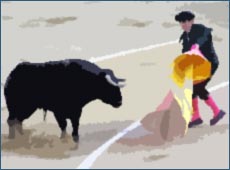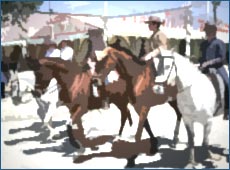|
|
|
|
 |
|
| |
| » |
Barcelona's Sagrada Familia |
» |
Feria de Abril, Seville |
| » |
Prado Museum, Madrid |
» |
Picos de Europa |
| » |
Alhambra Palace – Granada |
» |
Balearic Islands |
| » |
Guggenheim Museum Bilbao |
» |
Cordoba and the Mezquita |
| » |
La Tomatina Festival, Buñol |
» |
Toledo |
|
|
|
 |
| |
| Every spring, the town of Feria de Abril Seville throws a week-long party and one million people show up! La Feria de Sevilla began as a cattle trading fair in 1847, and through the years it has evolved into a sexy Spanish round-the-clock spectacle of flamenco, bullfighting and rowdy fun. Seville is considered the center of flamenco music and culture, which is also known as "Sevillana" because many of the composers and songs are from the city. |
| |
| Ground zero for the Feria festivities is the temporary tent city, on the far side of the Rio Guadalquivir, called the Real de la Feria. This rectangular piece of land is about a mile long and 700 yards wide. The tents, called casetas, are made of brightly-striped canvas and decorated with thousands of paper lanterns. While this set-up was originally created for the cattle market, today the casetas are temporary dance halls and each evening you'll find flamenco music and dancing from around 9pm to 6 or 7 the following morning. The women all wear spectacularly bright Gypsy-inspired flamenco dresses, and everyone--young and old--throws back a glass or two of sherry and gets out on the dance floor. |
| |
| The casetas are hosted by groups of aristocratic Sevillana families, clubs, trade unions and political parties. Each of the tents has its own atmosphere and traditions. Some are invitation-only affairs, while others are "open" and have commercial bars. So just roam around and find the vibe that works for you. One of the most notorious and fun casetas is "Er 77," where wine is drawn from a well and poured from buckets, and cots are offered in the back for napping. Another famous tent is "Los Duendes de Sevilla" (The Goblins of Seville) which is named for a painting by Alvarez Quintero. You can also expect a lively time at the casetas erected by Seville's many leftist and anarchist groups. |
| |
| In the afternoons, you can catch a glimpse of another Spanish staple--the bullfight. La Feria attracts top-notch matadors from all over Spain and the bullfights at La Feria are considered to be the best of the season. The action takes place at 5:30pm each afternoon at the imposing Plaza de Toros de Maestranza, which is known to locals as "the Cathedral" and is considered one of the most beautiful bullrings in the country. Tickets can be purchased at the bullring, and while they can be quite expensive, this is a chance to see the highest expression of this Spanish art form. You'll find the atmosphere at La Feria typically Andalusian--relaxed yet intense. Sevillians are outgoing and it will be easy to strike up a conversation and make new friends. |
| |
|
|
|



